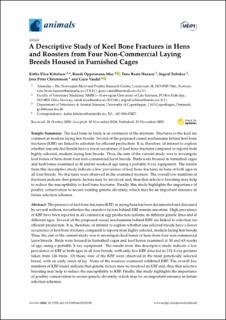| dc.description.abstract | The keel bone in birds is an extension of the sternum. Fractures to the keel are common in modern laying hen breeds. Several of the proposed causal mechanisms behind keel bone fractures (KBF) are linked to selection for efficient production. It is, therefore, of interest to explore whether less selected breeds have a lower occurrence of keel bone fractures compared to reports from highly selected, modern laying hen breeds. Thus, the aim of the current study was to investigate keel bones of hens from four non-commercial layer breeds. Birds were housed in furnished cages and keel bones examined at 30 and 63 weeks of age using a portable X-ray equipment. The results from this descriptive study indicate a low prevalence of keel bone fractures in hens at both ages in all four breeds. No fractures were observed in the examined roosters. The overall low numbers of fractures indicate that genetic factors may be involved and, thus that selective breeding may help to reduce the susceptibility to keel bone fractures. Finally, this study highlights the importance of poultry conservation to secure existing genetic diversity, which may be an important resource in future selection schemes. | |
